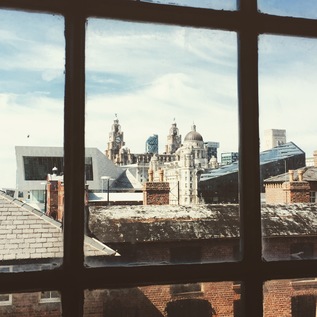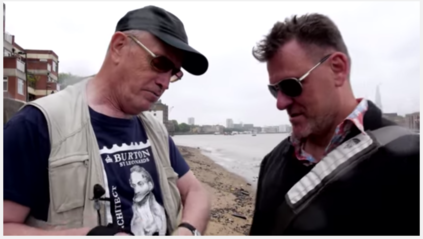It felt like a long time since I'd faced the challenge of getting a seat on a CrossCountry Voyager. Oddly, I was feeling really tense about the process. I'd taken all the usual precautions - booked the seats I wanted, located the point the train would stop at, everything short of booking a ridiculously early train which would be empty as per my usual tactics but somewhat unpopular in other quarters! As the unit rolled in, I noted someone in our seats and felt my anger rise. Boy did I need this break. It had been a long, complicated summer so far at work, and I'd been struggling to maintain a balanced view as things had whirled around me. In the event, whether it was my respectful pointing out that the seats were reserved or the fact that my knitted brows betrayed my anger, they moved. A few minutes later we were scudding north with the aircon working hard and I was feeling very happy to be back on the rails. It's moments like this that I realise that travel is essential to keeping me on track - in every sense. This trip, hastily planned but much looked-forward to, would take in Liverpool and Manchester - somewhere we'd liked on a previous visit along with a brief glimpse of a new city. For me it was a chance to revisit old haunts, ring the changes on the rails and to relax.
The first remarkable change I had to deal with was Birmingham New Street. A quick scan of posts on this site over the years will see that I visited often. Often enough to confidently plan ludicrously swift changes of train with time to collect coffee and breakfast on route. On trips where I needed to break a homeward journey I'd schedule in a break to drink coffee and watch the world go by while I waited for the always mysteriously quiet 18:42 home. I knew New Street well - and while it was drab, over-complicated and unfriendly in so many ways, I rather liked it. The redevelopment of the station and the retail complex above it began just as I drifted away from the rails and was completed last year, and I'd heard a lot about how different it was now. On arrival it didn't look too different at all - the stairs and escalators up to the concourse had received some attention and there were now helpful lifts at both ends of the platform - but otherwise it was still the gloomy dungeon it had always been. Then we stepped out of the lift into another world! I calculated, after getting my bearings, that we were on the site of the concourse which bridged the platforms in the old station. Passing through what would have been the site of the ticket gates we wandered into a lofty, bright atrium surrounded by retail units and restaurants. Sunlight streamed in from above, drawing the eye up two floors to the flagship John Lewis store. At ground level, a huge range of food options circled the atrium, with more stairs, lifts and escalators to access the other end of the platforms ahead of us. Everything was bright, clean and efficient. I was bewildered. Waiting in perhaps the rudest Starbucks I've ever visited while a quick John Lewis visit took place, I reflected on the change. I needed to come back and explore - to just walk the place, understand it. Replace old routes with new. Right now it was novel and strange, but unsettling. I couldn't navigate with the confidence which I'd always had here.
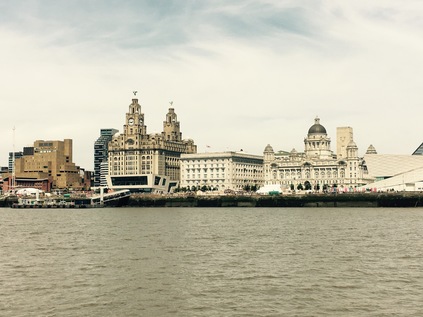
Back down on the much more familiar territory of platform 4C we boarded the Class 350 unit bound for Liverpool and enjoyed an M&S picnic as we set off for Wolverhampton. The train filled and emptied as we stopped at the smaller stations on the route, before navigating the recently opened junctions at Norton Bridge. The course of the new railway passed gracefully overhead, slightly disorienting me. But soon the terrain was more familiar - we were passing Basford Hall Yard, then calling at Crewe, and finally heading west at Weaver Junction and into the stretch of urban and industrial sprawl which runs along the north bank of the Mersey as it broadens into its estuary. Making good time, the scenery was a delight. Seeing the changing shape of Britain was such an everyday experience once - but now it genuinely feels like a privilege again. To do this on a warm summer afternoon in good company was even better. For the first time in a while I was feeling relaxed about this trip and it's potential for complications.
Arrival in Liverpool was, as ever, an impressive experience. Plunging into the deeply carved cuttings at Edge Hill we snaked into the lofty terminus at Lime Street and wandered onto the concourse. First stop was the taxi rank, then a swift spin around the city to our hotel which was near the waterfront and Moorfields station. The gentle slope down to the Mersey made for a fantastic view, with the ever-watchful Liver Birds visible over the rooftops. We spent a little time in the evening sitting outside the hotel, watching the sun slip low over the Wirral as the last few ferries plied their trade on the broad river. It was good to be back here, and good to be staying for a few days. On our first morning we took a tour bus to orient ourselves - my early walk across the city to find coffee had taken a similar route up to St. George's Hall and the station, but then the bus swung east to make the link between the two superb cathedrals - the beautiful modernist pinnacle of the Metropolitan Cathedral designed by Frederick Gibberd, and then Gilbert Scott's massive red stone hulk on St. James' Mount. We made a mental note to return here, but the lure of the river was strong and when the heat became almost too much we decided to take the ferry on its lazy looping route - north to the docks, west to Seacombe, south to Birkenhead and then back to the Port of Liverpool's angular but attractive new terminus. The deceptive breeze lured us into feeling pleasantly cool, and neither of us noticed the pink tint to our faces as we watched the water slip by from the deck.
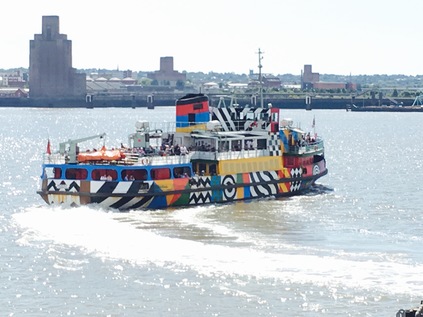
We combined the trip out to the cathedrals with a visit to Moose and Moonshine - a restaurant based on Moose the local brunch and coffee shop in town, which was unfortunately closed for refurbishment for much of our trip. It was probably too hot for breakfast foods - but as I contemplated a morning in the presence of two holy places, I needed earthly sustenance. Breakfast shouldn't be hard to come by, but in the cities of England it somehow seems to be now. It's a meal best found on the classless edgelands and suburbs - in grease-caffs and at roadside vans - but not in the self-conscious city. This then, was a real treat. Good, hearty, beautifully cooked breakfast! Afterwards, feeling sluggish but happy, we braved the roasting heat of the middle of the hottest day of the year to ascend the steps to the Catholic Metropolitan Cathedral. The awe-inspiring effect of the disconnected belltower and the circle of irregular blocks which seem to form a whole circle from a distance was remarkable. The lighting inside was equally impressive, with natural sunlight through subtle blocks of stained glass lighting the building like tubes of bright neon. We sat for a while, then circled the building. It was cool and calm inside, far preferable to the Graduation Day tumult of people sweating outside in gowns and ermine. Eventually we decided to leave and headed for the Philharmonic - a Liverpool institution - for a pint before heading back to the air-conditioned hotel room. The Anglicans could wait until next visit - a whole new cathedral for us to explore, perhaps after another breakfast?
Our plan was to leave Liverpool and spend a night in Manchester - it would be a first visit for one of us, a chance to orient to the city, and something that's worked well before. After a brief stopover in York for instance we knew we needed to revisit soon. The train was rather warm but pleasantly quiet and as we trundled over the canals and viaducts of Manchester, we were looking forward to getting to the hotel. I'd chosen one I'd frequented a number of previous times, which I hoped would provide for some good views. However, on arrival we realised that the promised refurbished rooms didn't have air-conditioning. The room had been baking in 32º heat all day, and even the provided fans weren't cooling us down. It was incredibly hot outside too, but thankfully we managed to get a seat outside a fine restaurant for dinner. Then it was back to the greenhouse of a hotel room for an uncomfortable night. When we checked out I invoked the 'good night guarantee' for the first time ever. The receptionist didn't seem surprised. I later discovered that some floors of the hotel do have air-conditioning as I'd thought - but the upper floors do not due to a dispute with the landlord of the building. I'm sure there were several refunds made that morning, indeed the gent who left before us seemed to have the same issues.
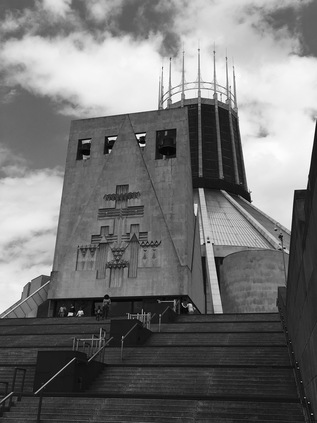
Our train home was a treat for me - a chance to travel again on the direct service from Manchester to Bristol which had once been a staple of my repertoire. I'd noticed some perturbation on the lines south to Birmingham all morning and I felt the return of the queasy uncertainty I'd had at the outset. Crosscountry haven't ever been the most reliable operator for me, but fending for two of us now felt different. As it happened, our train ran perfectly, and we soon slipped into our chosen seats and relaxed our way south towards home. Taking the new link at Norton Bridge confused me at first - the layout a mystery despite having read endless articles about it prior to its building. Not changing at New Street meant missing a chance to explore the station again - but given the heat and what seemed to be an even larger load of luggage, I wasn't sorry to be able to sit comfortably in our seats while the hordes battled over reservations in the time-honoured fashion. A departure via Proof House Junction and the Camp Hill line was a bonus reminder of the reasons I used to pick these trains home on a fairly regular basis - and I was a little nostalgic for my old evening ritual. A vacation on the rails had been a welcome change to our recent road trips - and Liverpool was just about the perfect city to visit by train. Already our next visit was shaping up - for starters we'd done virtually none of the Beatles-related sightseeing. In hindsight, the heat had probably meant we'd done far less of everything - except perhaps relaxing. For me, it was good to be back on the rails too, and exploring some of the changes to the network I once knew perhaps better than the back of my own hand. I've been away for far too long.
You can see more pictures from the trip here.
Arriving at the Rio Cinema yesterday, after an overheated morning walking to Barking Creek seemed odd. It was a fairly long leap from the stink of the River Roding's outfall to this rather special old building towering above Kingsland Road and proudly defying the sweep of new towers up from Dalston Junction. I was here for a film premiére - I can confidently say the first I have ever attended in fact. Schlepping in with my rucksack and my barely concealed aroma of the road and river, I was just a little concerned that I would be straying into a foreign world where I didn't fit. However, I was greeted at the door by the equally road-weary John Rogers - filmmaker responsible for today's feature, and long-time correspondent who I'd never actually chanced to meet in person. This is perhaps even more unlikely since we've trodden a fair amount of the same paths over the years of his filmmaking and my writing about a hard-to-pin down part of London which we both seem to instinctively know is our territory.
That said, I'd never flatter myself by comparison with John as, today's film being fine testament, he has managed to work with some of the most interesting and accomplished fellow walkers of this curious and liminal path in recent times. Firstly with his London Perambulator documentary following the idiosyncratic autodidact Nick Papadimitriou around his beloved Middlesex, and now with London Overground in which Iain Sinclair and Andrew Kötting retrace and disentangle their remarkable single-day walk around the now circular Overground railway line. The book is a curious journey - starting with shared stories and walking reveries between the duo, and drifting into a dreamlike middle-section as night falls and the city darkens. The tales drift away to other people and other times, the line somehow linking them back to a shared memory of the city. Where John has succeeded is in not simply trying to reproduce this walk - instead, the territory has been retrodden in sections, sometimes with both Sinclair and Kötting - occasionally, memorably reprising his 'straw bear' act from By Our Selves - but often with other fellow travellers like Chris Petit on hand. Indeed watching Petit and Sinclair strolling through Kensal Green cemetery is like eavesdropping on the private reminiscence between two old soldiers who have trodden and retrodden the material London offers, still finding new morsels and oddities all these years later. Kötting's much more down-to-earth antics are anchors, reminding us not to take this all to seriously. A walk is still a walk, despite the shifts and subtleties we might attribute to it. Despite how seriously it affected its particpants.
Because, in fact, John's film exposes the alarming conclusion of the book as one of it's central themes. Kötting's near-fatal motorcycle accident on his former home turf as he leaves London after the walk is as much the start as the end - the walk is a journey through his opiated memory, troubled by the recalled insertions of Sinclair's own history. As the damaged motorcyclist sleeps through his trauma, he rewalks and relives the circle of the Overground. The film moves fluidly through these dreamlike shifts between scenes and conversations and thus avoids being a mere documentary of a walk around a changing, disappearing London. Sinclair is candid and thoughtful throughout - able to talk with authority but little certainty about the last London - the city's end-stage as it moves into a post-post-Thatcherite era of offshore ownership and privatisation of land, air and water. His gentle tones and careful prose are pitched perfectly alongside John's camera work which is happy to linger on a curious railing or brick while the author speaks - a touch of Patrick Keiller in uncharacteristic close-up perhaps? Memorable too, are the scenes where Sinclair reads from the book to the accompaniment of local activist/solicitor Bill Parry-Davies' saxophone. These moments link Sinclair back to the beat poets he writes so effectively of in American Smoke - and to their own perhaps unexpected connections to the Overground railway too.
This cut of the film was edited specifically for this launch at the East End Film Festival, and there is every chance that by the time it sees another viewing it will include different scenes from the vast archive of footage which John built up on the walks and interviews he conducted. This is a good reason to seek out London Overground if you see it playing - it will be, a little like the railway which anchors it's existence - a changing and ever-surprising circuit.
I'm back where I ended my last walk, in Ilford. This morning feels a little different - arriving by rail into the Town Centre I have only the vaguest memory of how to get to the River Roding. Those first few moments of the bus journey a few weeks back were spent recovering from the deluge I'd been caught in, and the subtleties of the topography were a little lost on me. I sensed I was close though, navigating by the two tall glass towers of Pioneer Point which dominated the view from Redbridge on my last walk. Sure enough, there was the river sliding inauspiciously between British Telecom's Mill House offices and the North Circular. Marked only by a flourish of green between the buildings and a tiny blue sign, the river has calmed to its usual sluggish, benign flow. But as I've already discovered, following the Roding isn't easy or without challenge. The first was to get to the river: passing under the A406 I'm tempted by the concrete slopes beneath the overpass which imply they could provide a walkway at least part of the way to the water. Realistically though, there doesn't appear to be a way beyond the sliproads, so I negotiate some steps down to Grantham Road. Fronted by a series of tall, slightly ominous point blocks shielding it from Romford Road, this Little Ilford estate feels somewhat tense. A couple of older guys chat animatedly on the corner. I overhear a fragment: "feckin' Europe". It becomes apparent as I navigate the estate that Little Ilford is home to immigrants from the world over. It's the very kind of place where BREXIT feels illogical and it's attendant racism cruel - like a double body-blow. I lower my head and press on, passing a couple of young Indian guys systematically walking the streets and checking the wheelie-bins. For what? Between the stubby blocks to the east I spy a dog walker - always a good sign - and at the end of the short street a gateway to the park. I can feel the A406 reverberating nearby, so I delve into the greenery and find a grassy track which runs directly beside the road, undulating with its embankment and following the line of pylons which began to march alongside me back at Charlie Brown's Roundabout. Just like last time, the river is present but hidden. I'm walking its valley, but not its course.
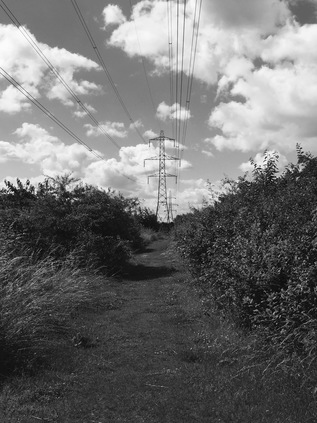
The largely untamed edge of the park is surprisingly bright and warm, and the walking is pleasant. Having a carpet of grass underfoot is a welcome change. It doesn't last though, and I'm eventually deposited onto the gravel track which circuits the much more primped sports field fronting a disused pavilion. A lone gymnast flips and tumbles across the grass as I edge around the park, trying to find a way through to the green space beyond. It turns out there is no way - so, turning back at the tennis courts I'm out onto the backstreets, deposited onto suburban roads named after painters: Reynolds, Dore, Leader and eventually Millais. The promise of a route under the A406 isn't delivered - if there is a footpath leading off the uninviting entrance to builders yards and reclamation specialists, it's well hidden indeed. Instead I turn west, heading towards the broad underpass which takes me under the London to Southend railway line. The bridge is wide enough for a road to pass beneath, but is hemmed in by barriers to prevent all but cyclists and ill-advised pedestrians from transiting into Barking. Unexpectedly, between two arms of railway I find the entrance to East Ham depot - a location I'd passed numerous times on the rails above, craning my neck for unusual stock. Once south of the delicate swan-neck of rails, Stevenage Road turned abruptly west to skirt the apparently disused Leigh Road Sports Ground. Rusting goalposts quivered in the wind, almost crossbar deep in reedy grasses. Across the vast swathe of grass the North Circular hovered on its tall concrete legs, with the lush foliage of the river beneath. A footbridge was again promised by the OS map, but there was no access to the sports ground - a notice offering 'multiple hazards' to any who dared. A deflated gasholder and its outbuildings sat defiantly in the midst of the overgrown space and reflected a strong morning sun back at me. There was definitely no way in, or out onto the river.
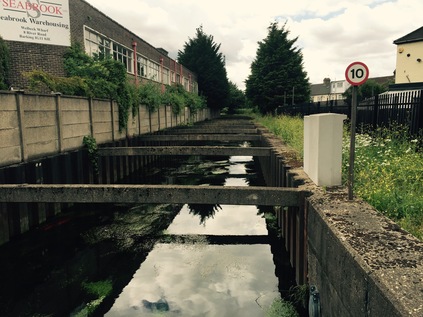
Instead I turned east again along the dusty run of Watson Avenue. One side a high fence, regularly dotted with signs declaring the unimaginable and manifold horrors that would befall anyone trying to access the sports ground, on the other a run of pleasant but tired suburban houses. There's no-one to be seen at all. At the end of the street, a steep footbridge climbed directly over the North Circular. No messing around with tiers of stairs or carefully graded accessibility ramps, just a stepped ascent to the height of a gantry sign. Traffic rushed under a threatening sky, broken with flashes of bright light. From the north, the glassy faces of Pioneer Point winked pale sunlight back at me. This crossing of the road was exhilarating - and it marked a return to the river at last. That return was via the menacing and littered Hertford Road, and a dank, debris-strewn passage beside a Big Yellow Storage Centre which lead to another bridge - this time over the Roding. Here the river was broad and slow-moving, approaching its final meanders towards the Thames. On the west bank, a broad well-made path edged the water. North of here it terminated in a blank wall, but south it appeared to continue by way of the curves of the river towards a gigantic Tesco store. I followed the river path gratefully, not even noticing the faint faecal tang on the air. Surfacing to briefly visit Tesco, I hugged the river wall and edged out of their extensive Car Park beside the Ibis Hotel. I had been here before - and with some confidence I strode along Fresh Wharf Road, passing the inert security checkpoint which had concerned me last time. In the interim I'd discovered it shouldn't be this way. There is, theoretically a route along the west bank of the river - but a dispute between the Fresh Wharf Estate and the owners of houseboats moored at Barking appears to have resulted in it being blocked. While court action has secured them access to their homes, the through-route remains blocked. Instead I turn east again beside the institutional grey block of the Police Custody Centre, heading along a well made path which runs along Hand Trough Creek. Behind the building, hatless but fully body-armoured Policemen smoke committedly between shifts. I emerge at the gated entrance to the moorings and cross the weir by way of the lock gates. I'm finally east of the Roding and with a fairly good path to walk which appears to have been constructed when the modern blocks of flats which front the river were built. I wonder at these places - innocuous, tiny properties packed into serrated blocks which tower above the sluggish channel. The location is promising enough: looking out over the vast sewage complex at Beckton and its neighbouring leisure park offering of American diner and multiplex cinema. Ahead, the A13 crosses on a low concrete bridge, and my pathway is soon pressed up against the wall of the overpass, vegetation hanging above. I emerge at the bottom of a footbridge I'd crossed on my A13 walk, the road seething beside me. I felt like I'd come home.

It was oddly comforting to cross the footbridge over the familiar surge of traffic, watching my hand blacken with heavy particulate as I ran it along the guardrail. I'd been away from my A13 walk for a while now - trying to determine the logistics of the long rural sections ahead - but seeing the road churning along beneath me and remembering a successful walk here made me want to return this part specifically. As I head east briefly towards my turning, a host of wild poppies colonise the mesh of a fence. There is life here, on the edge of things. As built-up Barking gives way to the flat, empty riverside plains of Dagenham, River Road turns south to edge along the Creek. As I trudged out to the junction where I'd turn, I noted a little knot of housing trapped between the road and the industrial area. It must feel strangely embattled here in what remains of Creekmouth - once a tiny village at the confluence of Thames and Roding, now more of a conceptual sales pitch for industrial sites which might one day be served by the Overground. These houses are an outpost - neither here, nor especially there. Creekmouth is gone, buried by refused and scrap metal. Once into River Road, the landscape quickly flattens out into low-rise brick units of industry; The junction crosses the Mayes Brook at an oblique angle which makes its last dive between the back gardens of houses to reach the Creek. The river isn't present at first - after passing under the A13 it makes a brisk eastward turn to run parallel to the Thames briefly, almost resisting its final destination. Eventually though, road and river are running alongside each other and the broad swathe of industry on the western side of the street is all that separates me from the muddy channel. River Road seems to run on forever, a long straight canyon of dust and debris. Piles of fly-tipped house clearances regularly interrupt the path - and one of them partially hides a globe: its dusty continents and battered reliefs peeking out from under the rubble. I finally reach the Waste Transfer Facility which by my calculation borders the Creekmouth Green Space - and it is an utterly horrible last barrier. An evil-smelling swirl of black liquid runs down the sloped entrance road and pools across the footpath, eddying rainbows of oils and fats twinkling up at me. The smell is incredible. Acrid, decaying refuse, sweet hydrocarbon, musty ancient river silt and the human tang of sewage. It fills my nostrils as I push at the creaking gate and walk up the rise towards the bank. I thought I'd built up a resistance in my years working on the edges of the care industry, but it overwhelms me sufficiently by the time I reach the river that it is beyond a mere smell anymore - now it's inside my head. I wonder with some horror whether I'll be stuck with this reek in my nostrils forever? It's an unfortunate time to be awestruck too as I turn, slack-jawed into the open at last- but the sharp-intake of tainted air is worth it: the Barking Flood Relief Barrier towers overhead. Up close, it is notable that the slender concrete pillars are studded with portholes. The idiotic capering figure on the Environment Agency logo shimmers in the haze of heat and pollutants atop each tower. Between the towers, the Isle of Dogs is framed perfectly in the distance. Beside me, the sweep of the Thames takes up the Roding's waters - now a broad estuary in its own right, but dwarfed by the might of the greater flow. I've seen wider vistas further east - bleaker, emptier frames of sky and river - but the end of Barking Creek has an end-of-things quality. I feel like I've walked a long, often fruitless trail from Debden, spending more time navigating the twists and turns of suburban East Ham and Ilford than I've spent on the bank of the river. But hemmed in by the infrastructure of the twentieth century I've honoured the course of this persistent watercourse. It's time to head back.
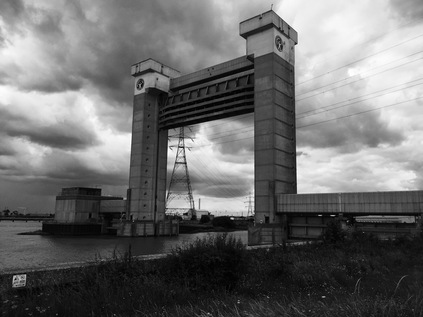
I'm waiting for a bus on River Road when the rain starts. A small group of Central European factory workers dash over to shelter under the awning of an industrial unit where they converse languidly about BREXIT with regular shrugs and shakes of the head. I stay out in the refreshing storm. It won't last, and the cool clean rainfall is welcome. I see rivulets of black trickling from my hands where I'd picked up the road grime, and I smell the curious but never unwelcome aroma of dry dusty pavements getting wet. The bus finally arrives and we all board - heading back to civilisation and away from this spot which most of us would only ever visit under duress. Almost everyone except me.
You can find a gallery of images from the walk here.
Lost::MikeGTN
I've had a home on the web for more years than I care to remember, and a few kind souls persuade me it's worth persisting with keeping it updated. This current incarnation of the site is centred around the blog posts which began back in 1999 as 'the daylog' and continued through my travels and tribulations during the following years.
I don't get out and about nearly as much these days, but I do try to record significant events and trips for posterity. You may also have arrived here by following the trail to my former music blog Songs Heard On Fast Trains. That content is preserved here too.
